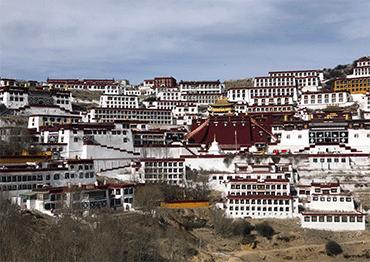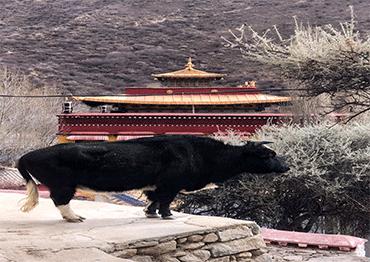Any visit to Xizang Autonomous Region feels like an adventure into the unknown. Nevertheless, Xizang is considered a bucket-list destination for many people around the world, and tourism is clearly starting to develop into a mature industry. On the plus side, this development has brought elements of convenience. Many places now have signs translated into English, restaurants serve pizza as well as yak’s cheese dumplings, and numerous hotels cater for international visitors (and boast the ‘international toilets’ to prove it). However, for each comforting convenience there is a lingering fear that some cultural authenticity is being eroded.
Almost all tours of Xizang follow a rather predictable itinerary. This is not to say that the itinerary is a bad one. On the contrary, the typical tourist itinerary in Xizang manages to capture many of the region’s most magnificent and historically important destinations within just one week, including important towns, monasteries and of course Mount Qomolangma (Everest). However, to limit oneself to just one week in Xizang is to exclude the opportunity of visiting an equal number of fascinating destinations that lie beyond the orbit of almost all organized tours.
Even in the city of Lhasa itself there are a lot of interesting destinations to visit that lie beyond the remit of most commercial travel companies. This is in part because Xizang is adorned with an unbelievable number of temples, monasteries and nunneries. Some of Xizang’s religious locations are awe-inspiring in part due to their magnificent scale, such as Tashilhunpo Monastery in Xigaze, which is essentially an entire walled city, and the Potala Palace, towering over Lhasa. However, others are worth visiting precisely because they are smaller, practical and allow for easier insight into the real daily life of their committed inhabitants. Certainly, a visit to Ani Tsankhung Nunnery does not require an entire afternoon. However, sitting, relaxing and observing the life of the shaven-headed nuns who live in this charming nunnery, tucked into the backstreets of central Lhasa, is a soothing experience for both the soul and the mind. Unlike in the major destinations, visitors are likely to find that they are the only outsiders in smaller temples at any one time. Most still charge a nominal fee to enter, and the inhabitants, though friendly, tend to ignore visitors as they carry on with their important daily chores. Many of these destinations provide small vegetarian kitchens and public restrooms. Other such hidden delights in Lhasa City itself include Ramoche Monastery, Kundeling Temple and the Norbulingka.
However, to truly leave the beaten tourist pathways of Xizang, one must venture outside Lhasa and explore the fascinating cultural offerings of Xizang’s smaller towns and villages, which lie nestled in the Himalayan mountains and gently merge with the grasslands of the Qinghai-Xizang plateau. One such fascinating destination is Drak Yerpa Monastery, which lies to the northeast of Lhasa in Dagzê County. The jagged, rugged and imposing cliffs of Drak Yerpa contain some of the earliest known meditation sites in Xizang, including small caves used as temples, shrines and hermitages, some of which pre-date the Buddhist era. The most famous of these historic sites relate to Songtsen Gampo (604-650 BCE), often considered the first king of a united Xizang, and whose queen, Monza Triucham, founded the Drak Yerpa Monastery itself. Like so many attractions in Xizang, it is the integration of raw, desolate and savage wilderness, with the peaceful and traditional lives of the residents, that is so fascinating and surprising.
Dagzê County is also home to Ganden Monastery, one of the three great university monasteries in Xizang that follow the dominant gelug school of Tibetan Buddhism. Ganden Monastery sits atop Wangbur Mountain at 4,300 meters, significantly higher than Lhasa, although by no means the highest altitude for a religious site in Xizang. Ganden Monastery is now no longer as extensive or magnificent as it once was, with the monk population capped at 400. Nevertheless, any visitor can clearly feel that the monastery is essentially an independent isolated religious settlement, with numerous narrow stone alleyways, along which one could seemingly wander for days, enjoying the alternating smells emanating from vegetarian kitchens, incense burning temples and domesticated yak. The geographic position of the temple also makes it a perfect vantage point for a visitor to stare out across the seemingly endless expanse of Xizang. With barely any sign of human life, the open wilderness serves to remind one of human limitations and one’s own insignificance.
Slightly further afield, and to the south of Lhasa, is Samye Monastery in Dranang County, Shannan Region. Samye Monastery is one of the most influential religious sites in Xizang. It is often regarded as the first Tibetan Buddhist monastery to have been built in Xizang, dating back to 763. The monastery is designed to replicate Odantapuri Temple in Bihar, India, and has itself been the influence for other buildings, such as Puning Temple in Chengde, Hebei Province. Samye Monastery is a huge, enclosed space. However unlike Ganden, Tashilhunpo, Drepung and Sera monasteries, which feel like tight medieval citadels, Samye Monastery feels very open and spacious. This is because the monastery is designed to replicate the Buddhist universe, or a mandala. It contains a central temple surrounded in a semi-symmetrical fashion by additional temples each with important imagery and a unique design, all within a large circular wall. About 16 kilometers away from Samye Monastery are the Chimbu Caves, otherwise known as the Chimbu Hermitage. This sacred site is fascinating, not only due to the entrancing chanting and drum beating of the resident nuns, but also for the hundreds of monks and nuns who apparently meditate as hermits for extended periods of time in the many caves that are scattered across the mountain.
However, if one truly wants to visit an authentic town and an authentic monastery in Xizang, then arguably one cannot beat Yangpachen Monastery in Yangbajain. While Yangpachen Monastery is much smaller than Samye and Drepung, it is nonetheless extremely significant from an historic perspective, dating back over 500 years. The monastery was once the seat of an important lineage of historical Tibetan religious leaders. Now, however, the monastery feels extremely isolated, quiet and reflective. The few residents who emerge are certainly fascinated to see a foreign visitor. Indeed, their look of surprise is not something that one would ever encounter from a monk or nun in one of the larger and more famous monasteries. This alone is an indication that you are visiting somewhere very special, that few others are lucky enough to experience.
Xizang has an absence of rain for most of the year, although it can rain in the summer months. While the winters are clearly colder than the summers, they are milder than one might expect, making Xizang a good year-round destination.

 Old Version
Old Version

